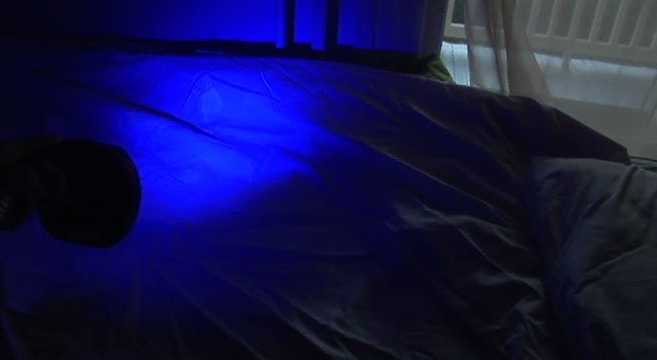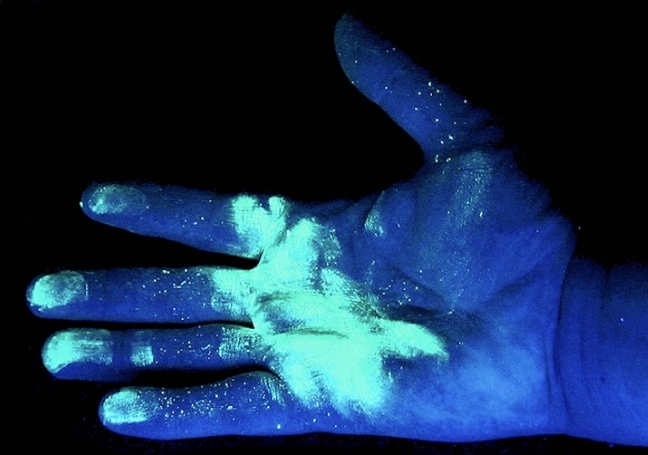The post How UV Light Reveals Hidden Evidence at Crime Scenes appeared first on Tank007.
]]>1. The Science Behind UV Light in Forensics
UV light is a type of electromagnetic radiation with wavelengths shorter than visible light but longer than X-rays. In forensics, two main types of UV light are commonly used:
- UV-A (Longwave): 320–400 nm, less intense, often used for general searches.
- UV-C (Shortwave): 100–280 nm, more intense, effective for revealing specific substances.
How UV Light Works: When UV light shines on certain substances, they absorb the energy and re-emit it as visible light—a process known as fluorescence. Many biological materials and synthetic substances fluoresce under UV light, making them easier to detect.
2. Common Types of Evidence Revealed by UV Light
| Type of Evidence | UV Wavelength Used | Fluorescence Color | Common Applications |
|---|---|---|---|
| Bodily Fluids (e.g., blood, saliva, semen) | UV-A (365 nm) | Blue, green, or yellow | Sexual assault cases, violent crimes |
| Fingerprints (with fluorescent powder) | UV-A (365–395 nm) | Bright blue or green | Burglary, theft |
| Fibers and Textiles | UV-C (254 nm) | Various colors | Linking suspects to crime scenes |
| Bone Fragments | UV-C (254 nm) | Pale white or green | Mass graves, cold cases |
| Drugs and Narcotics | UV-A (365 nm) | Blue or green | Drug enforcement |
Insight: Choosing the correct UV wavelength is essential for maximizing evidence detection.
3. How UV Light Detects Bodily Fluids

Bodily fluids like semen, saliva, and sweat contain compounds that fluoresce under UV-A light due to proteins and enzymes. However, blood does not fluoresce naturally; it absorbs UV light instead, appearing black or dark.
Method:
- Investigators darken the room and use a UV-A flashlight.
- Protective goggles are worn to enhance visibility of the fluorescence.
- Fluids emit blue, green, or yellow fluorescence, helping identify their locations.
4. Using UV Light for Fingerprint Detection
Fingerprints are made visible under UV light when treated with fluorescent powders or dyes such as Rhodamine 6G or Ninhydrin. The oils and sweat in prints can also fluoresce directly.
| Detection Method | Advantages | Disadvantages |
|---|---|---|
| Fluorescent Powder + UV-A | Clear visibility, effective on non-porous surfaces | Requires careful application |
| Ninhydrin + UV-A | Useful on porous surfaces (e.g., paper) | Time-consuming to develop |
| Direct UV Light (No Powder) | Quick and easy | Lower contrast, limited to fresh prints |
Recommendation: Using fluorescent powder and UV-A light offers the best results for non-porous surfaces.
5. Comparing UV Wavelengths for Forensic Applications
| UV Wavelength | Common Uses | Advantages | Disadvantages |
|---|---|---|---|
| UV-A (Longwave, 365–395 nm) | Bodily fluids, fingerprints, narcotics | Less damaging to evidence, portable | Lower fluorescence intensity |
| UV-B (Midwave, 280–320 nm) | Rarely used in forensics | Moderate fluorescence | Potential skin damage to investigators |
| UV-C (Shortwave, 100–280 nm) | Fibers, bone fragments, aged blood | High fluorescence, effective for trace evidence | More dangerous, requires protective gear |
Key Insight: For safety and effectiveness, UV-A light is the most commonly used in field investigations.
6. Case Studies: UV Light Solving Crimes

Case Study 1: The Hotel Room Assault
- Situation: A suspected assault in a hotel room.
- Method: Investigators used a 365 nm UV-A flashlight.
- Findings: Detected semen stains on bedsheets that were invisible under normal light.
- Outcome: Provided critical DNA evidence that led to a conviction.
Case Study 2: Drug Trafficking Bust
- Situation: Narcotics hidden in a car dashboard.
- Method: UV-A light used to detect traces of fluorescent-tagged drugs.
- Findings: Confirmed the presence of cocaine residues.
- Outcome: Helped secure charges against suspects.
Conclusion: These cases highlight the practicality and reliability of UV light in uncovering hidden evidence.
7. Challenges and Limitations of UV Light in Forensics
| Challenge | Impact | Solution |
|---|---|---|
| Background Fluorescence | False positives due to materials like detergents | Use contrast filters and multiple wavelengths |
| Degraded Evidence | Reduced fluorescence in aged samples | Enhance using chemicals like luminol |
| Health Risks | UV-C can cause skin and eye damage | Wear protective glasses and clothing |
Recommendation: Proper training and equipment are essential for safe and accurate UV light use.
8. Maintenance Tips for UV Flashlights in Forensics
- Regular Cleaning: Use alcohol wipes to remove residue from the lens.
- Battery Check: Ensure full charge to maintain optimal brightness.
- Wavelength Calibration: Verify with a spectrometer if available.
Tip: Store UV flashlights in protective cases to avoid lens scratches.
9. Summary of Key Findings
| Aspect | Key Insight |
|---|---|
| Best Wavelength for Forensics | UV-A (365 nm) for most biological and trace evidence |
| Most Common Evidence Detected | Bodily fluids, fingerprints, fibers |
| Top Challenges | Background fluorescence, safety risks |
| Recommended Practice | Use protective gear and combine wavelengths |
Conclusion: UV light is an essential tool for forensic investigations, capable of revealing hidden evidence quickly and efficiently. By understanding the science and limitations of UV light, investigators can maximize its potential in solving crimes.
The post How UV Light Reveals Hidden Evidence at Crime Scenes appeared first on Tank007.
]]>